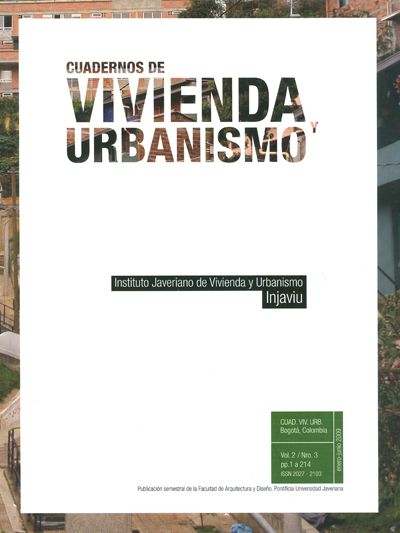Abstract
This article is a contribution to the discussion on the development of urban peripheries in mountainous environments. The study was performed around the city of Manizales, Colombia, following a three-phase methodology: structure, form and function, starting from physical and social components in order to define peri-urban dwelling. The result is the description of a series of habitat units called “holón”, neighborhoods situated in peripherical and suburban areas of Manizales, which, when studied together, prove socio-spatial fragmentation. This article contributes to the understanding of urban growth patterns in the coffee-growing region of Colombia. Its methodology is applicable to socio-spatial studies on habitat, local urban policies on environmental management, planning of urban expansion and physical and social risk management
Barros, C. (1999, agosto). De rural a rururba-no:”transformaciones territoriales y construcción de lugares al sudoeste del área metropolitana de Buenos Aires”. Scripta Nova, Revista electrónica de
Geografía y Ciencias Sociales. [En línea] 45, 52. Disponible en: http://www.ub.es/geocrit/sn-45-52.htm
Bertrand, G. (1982). Paisaje y Geografía física global. En J. Gomez. El pensamiento geográfico. Madrid: Alianza Editorial.
Bettini, V. (1998). Ecología urbana. Barcelona: Editorial Gedisa.
Bunge, M. (1972). Teoría y realidad. Barcelona: Ariel.
Capra, F. (2003). La trama de la vida: una nueva perspectiva de los sistemas vivos. Barcelona: Anagrama.
Carter, H. (1972). The study of urban geography. London: Picador.
Corpocaldas. (2003). Plan de gestión ambiental del municipio de Manizales. Colombia (s.d.)
Dematteis, F (1998). Suburbanización y periurbanizacion: ciudades anglosajonas y ciudades latinas. En: Monclus, F. La ciudad dispersa. Barcelona: Centro de cultura contemporánea.
Durán. F. (2003, año 6). Los límites difusos de los territorios periurbanos: una propuesta metodológica para el análisis de su situación socioeconómica y proceso de cambio.Sociologías. 11,. 28-63.
Fuente: Introducción a los conceptos básicos de la Teoría General de Sistemas. Cathalifaud, M y Osorio, F. (1998, agosto). Cinta de Moebio. 3. Via RedAlyc,. www.redalyc.uaemex.mx/redalyc/pdf/101/10100306.pdf.
Goodchild and Mark,D. (1987). The fractal nature geographic phenomena. Anals of the associations o american geographers. 77:2, 265-278.
Gómez, J. (1982). El pensamiento geográfico. Estudio interpretativo y antología de textos. Madrid: Alianza Textos
Goueset, V. (1998). Nacimiento de una metrópoli:.La originalidad del proceso de concentración urbana en Colombia en el siglo XX. Observatorio de Cultura Urbana, CENAC, IFEA, FEDEVIVIENDA. Bogotá: TM editores.
High, M. (1987). The Holon: Hierarchy theory and landscape research. CATENA. 1881- 192. Trad. Antonio, F. En: Cuadernos de Geografía. Bogotá: Universidad Nacional de Colombia.
Harvey, D. (1985). Urbanismo y desigualdad social.,Madrid: Siglo XXI.
Howley, A. (1962). Ecología Humana. Barcelona: Siglo XXI.
Instituto Alexander von Humboldt. (2004). Manual de métodos para el desarrollo de inventarios de biodiversidad. Programa de Inventarios de Biodiversidad, Grupo de Exploración y Monitoreo Ambiental (GEMA) Bogotá (s.d.).
Koestler, A.(1967). The ghost in the machine. London: Picador.
Lefebvre, H. (1975). El derecho a la ciudad. Barcelona: Anagrama.
Mandelbrot, B. (1968). Los objetos fractales. Metatemas 13. Barcelona: Tusquets ed.
Melo, l. (2004). Folleto sobre cobertura y uso de la tierra. Bogotá: IGAC- CIAF.
Ministerio de Ambiente, Vivienda y Desarrollo territorial. (2004). Lineamientos para optimizar la política de desarrollo urbano. Documento COMPES 3305. Bogotá: Publicación interna.
Palh, R. (1965). Urbs in rure. The metropolitan fringie in Hertfordshire. London: School of economic and Political Science, Geogr.
Pattee, (1973). Unsolved problems and potential aplications of hierarchy theory. Hierachy theory: the challenge of complex systems. 130-156. New York: , Braziller inc.
Prigogine, I. (1971). Thermodynamic theory of structure, stability and fluctuations, New York: Wiley.
Prigogine, I y Stengers, I. (1984). “Order and Chaos”. man’s new dialogue with nature. New York: Banta.
Santos, M. (1982). Ensayos sobre a urbanizacao latino- americana. Sao Paulo: Banta.
Versluys, J. (1956). The social implications of industrialization and urbanization five studies in Asia, Calcuta. International Journal of Comparative Sociology. 4:2, 140-151.
Villegas, F. (1999). Evaluación y control de la contaminación. Bogotá: Ed. Universidad Nacional de Colombia.
This journal is registered under a Creative Commons Attribution 4.0 International Public License. Thus, this work may be reproduced, distributed, and publicly shared in digital format, as long as the names of the authors and Pontificia Universidad Javeriana are acknowledged. Others are allowed to quote, adapt, transform, auto-archive, republish, and create based on this material, for any purpose (even commercial ones), provided the authorship is duly acknowledged, a link to the original work is provided, and it is specified if changes have been made. Pontificia Universidad Javeriana does not hold the rights of published works and the authors are solely responsible for the contents of their works; they keep the moral, intellectual, privacy, and publicity rights.
Approving the intervention of the work (review, copy-editing, translation, layout) and the following outreach, are granted through an use license and not through an assignment of rights. This means the journal and Pontificia Universidad Javeriana cannot be held responsible for any ethical malpractice by the authors. As a consequence of the protection granted by the use license, the journal is not required to publish recantations or modify information already published, unless the errata stems from the editorial management process. Publishing contents in this journal does not generate royalties for contributors.


